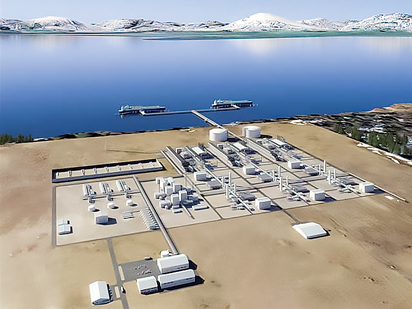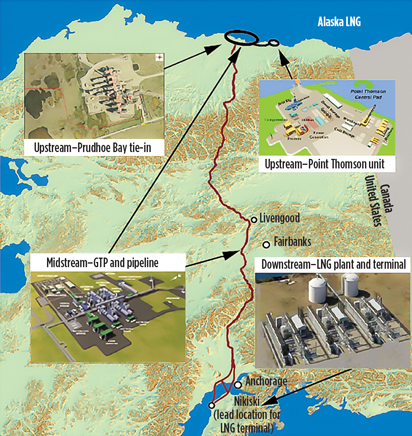Boxscore Construction Analysis
A. Blume, Managing Editor
Adrienne.Blume@GulfPub.com
The Alaska South Central LNG (Alaska LNG) project, which was in the late conceptual stage in late June, would involve the construction of an LNG plant, an LNG storage terminal, a gas treatment plant and two new pipelines.
A joint venture (JV) of ExxonMobil, ConocoPhillips, BP, TransCanada and the state of Alaska, the project is estimated to cost $45 billion (B) to $65 B, in 2012 dollars.1
Mega-project scope. The Alaska LNG project, if completed, will be a massive development. A 58-mile (mi) pipeline would be built to carry gas from the in-development Point Thomson gas field to Prudhoe Bay in Alaska’s North Slope region, where a large-scale gas treatment facility would be constructed to remove carbon dioxide and other impurities from produced gas. The facility would include four amine trains with compression, dehydration and chilling, as well as infrastructure and utilities. The plant would be modularized and sea-lifted to Prudhoe Bay, and then assembled onsite.
An 800-mi, 42-inch pipeline with eight compression stations would be built to carry the treated gas from Prudhoe Bay to Nikiski, Alaska, located along Cook Inlet. The pipeline would be designed to manage both continuous and discontinuous permafrost regions. Additional gas compression and/or expansion capacity could be added, if necessary.
At Nikiski, an LNG terminal, storage tanks and shipping facility would be constructed. The terminal would produce 17 million metric tons per year (metric MMtpy) to 18 metric MMtpy of LNG from 2.2 billion cubic feet per day (Bcfd) to 2.4 Bcfd of natural gas. The plant would consist of three trains with a capacity of approximately 5.8 metric MMtpy each. A small volume of stabilized condensate would also be produced. Storage would consist of two to three 160,000-m3 LNG tanks. The marine offloading facility would comprise one or two conventional jetties, two berths and a marine support system. Fig. 1 shows the computer-rendered conceptual layout of the proposed LNG terminal.
 |
|
Fig. 1. Computer-rendered conceptual layout of the proposed Alaska LNG facility |
The Prudhoe-to-Nikiski pipeline would be designed to transport 3 Bcfd to 3.5 Bcfd of treated gas. Some of this gas would be consumed directly by resident Alaskans, and the remainder would be used to operate the pipeline and as feedstock for the LNG terminal. Fig. 2 shows the planned layout of the entire project and the locations of each segment.
 |
|
Fig. 2. The Alaska LNG development would be one of the largest in the world |
Project progress and target market. In April, the Alaska Legislature approved legislation to allow negotiations between pipeline firm TransCanada and North Slope gas producers for the development of the Alaska LNG project. The modified laws will pave the way toward the state of Alaska becoming an equity partner in the project. An agreement to this effect was anticipated to be signed by the end of June. The agreement would move the project into the pre-front-end-engineering-and-design (pre-FEED) stage, which could see completion in 2015 or early 2016.
The project’s partners are targeting the nearby expanding Asia-Pacific demand market, which could double in volume by 2025. However, a number of LNG projects in British Columbia, Canada, are also eyeing this market. The huge volume of LNG that would be produced from the project would enter the market at once, forcing the JV partners to ensure outlets for the product prior to making a final investment decision (FID).
The FID will likely take several years; Black & Veatch, which is advising the state of Alaska on the project, reports that an FID could come in 2019, at the earliest. The FID for Alaska LNG is heavily dependent on securing LNG buyers and project permits. Pre-FID spending, which is typically less than 10% of the total cost of a project, is estimated at $2.4 B for Alaska LNG’s pre-FEED and FEED. It is customary for large-scale LNG projects to secure commitments from customers for the majority of the LNG output before the FID is made.
Alaska LNG’s $45 B–$65 B cost—the majority of which covers the LNG plant and the 800-mi pipeline—has been called prohibitive by some analysts. If the large-scale gas project is scrapped because the projected profits would not be worth the high project cost, a second option could be to convert stranded gas on the North Slope into GTL. A smaller-scale GTL plant would be an ideal option for the North Slope, where large-scale facilities are cost-prohibitive and difficult to permit.
The GTL products could be shipped to markets through the under-utilized Trans-Alaska Pipeline system. Such a plan would still generate revenue for the state of Alaska, despite the lack of a short-term, mega-construction boom of the kind that would be required by Alaska LNG. Instead, steady construction demand of 10 years or more would support a small increase in construction employment, particularly fabrication work.2
In Alaska LNG’s October 2012 work plan, the JV partners acknowledged that possible challenges in the lead-up to FID include “…protracted resolution of fiscal terms, permitting and regulatory delays, legal challenges, changes in commodity market outlook, time to secure long-term LNG contracts, labor shortages, material and equipment availability or weather.”3
In late June, ConocoPhillips CEO Ryan Lance said that the mega-project can be developed under the right conditions, despite a rising number of competitors. Although the project has not filed for any permits, it is ready to move on practical fiscal terms and supply costs, Mr. Lance said.4
Next steps for Alaska LNG. The next steps to be taken during the pre-FEED stage include securing state and federal government support for the project, building out the business structure and financing plan, assessing potential commercial viability, and securing permits and land-use agreements.
If these goals are reached, then the FEED stage will begin. During the FEED stage, financing permits will need to be secured, stakeholder agreements must be signed and commercial agreements will need to be struck. Also, commercial viability will need to be confirmed and engineering, procurement and construction (EPC) contracts will be issued. At this time, an FID would need to be made. During the EPC stage, final engineering, fabrication, logistics, financing and permitting issues would be resolved.
In a March presentation prepared for the Senate Finance Committee by the Federal Coordinator for Alaska Gas Line Projects, the coordinator advised patience during state LNG investment. Although returns on investment from a project on the scale of Alaska LNG will take time, the project will give an extended payback. “If [Alaska] wants to act like an oil and gas business, then it must think like one—and think long term,” the coordinator advised.5
The next few years could bring fluctuations in the LNG market that may prompt the JV to issue an FID before the onset of the next decade. It remains to be determined if the scope or scale of the project will change, and whether or not adequate LNG offtake commitments can be secured. The JV partners, along with the state of Alaska, are working diligently to make Alaska LNG’s potential profits worth the projected cost. GP
Literature cited
1Alaska Natural Gas Transportation Projects, Office of the Federal Coordinator, “Alaska LNG project,” April 20, 2014.
2Bradner, T., “Without LNG, what’s our Plan B?” Anchorage Daily News, June 15, 2014.
3DeMarban, A., “ConocoPhillips CEO says Alaska LNG project has potential,” Alaska Dispatch, June 24, 2014.
4Lee, J., “Final investment decision: The big breakthrough,” Office of the Federal Coordinator, April 8, 2014.
5Persily, L., Federal Coordinator for Alaska Gas Line Projects, “Alaska gas pipeline project: What’s different this time?” March 10, 2014.




Comments